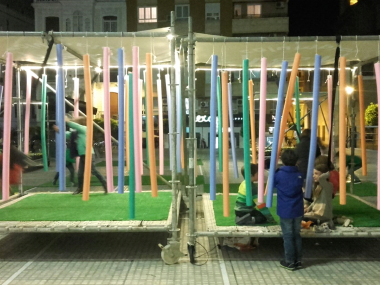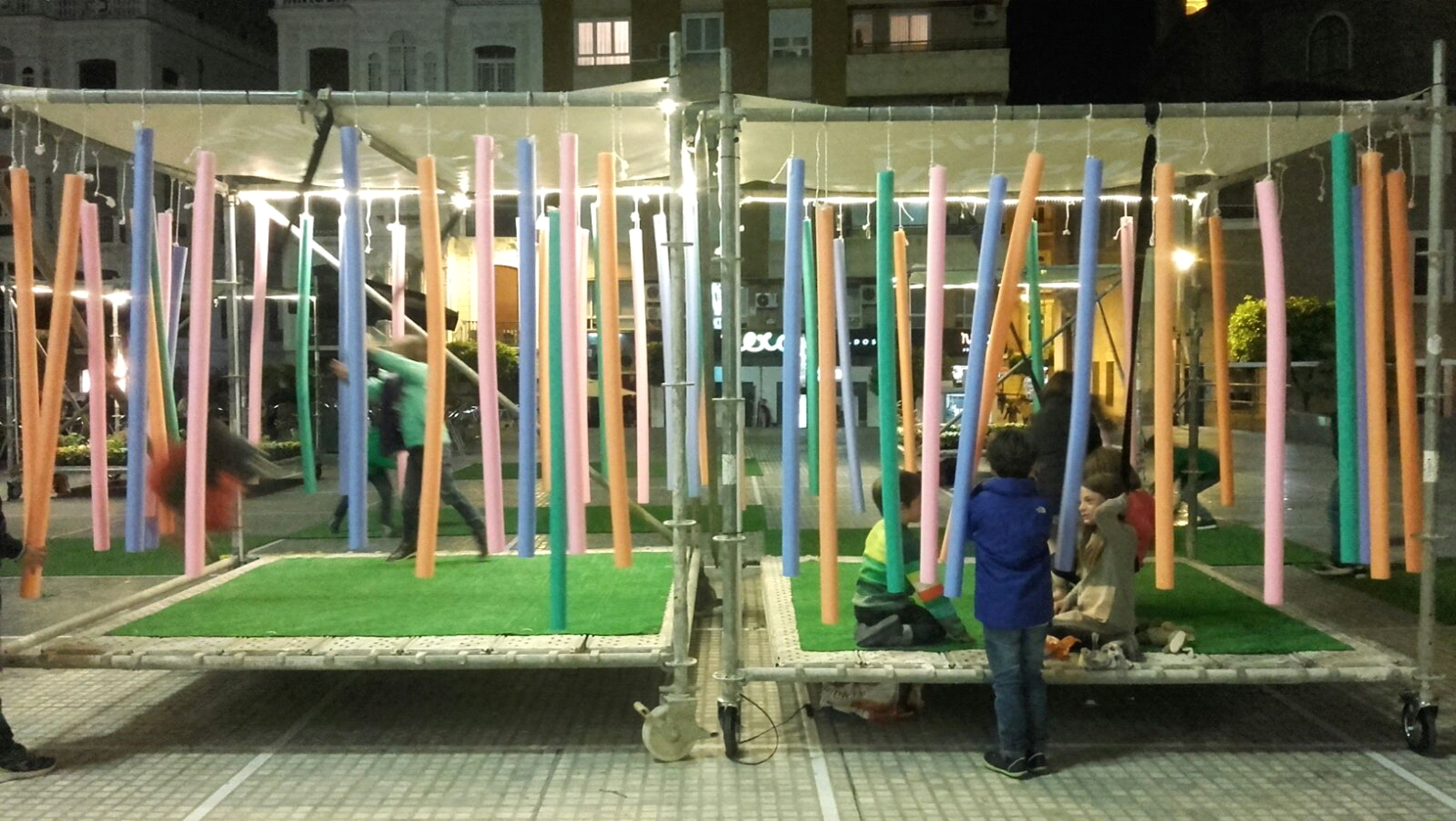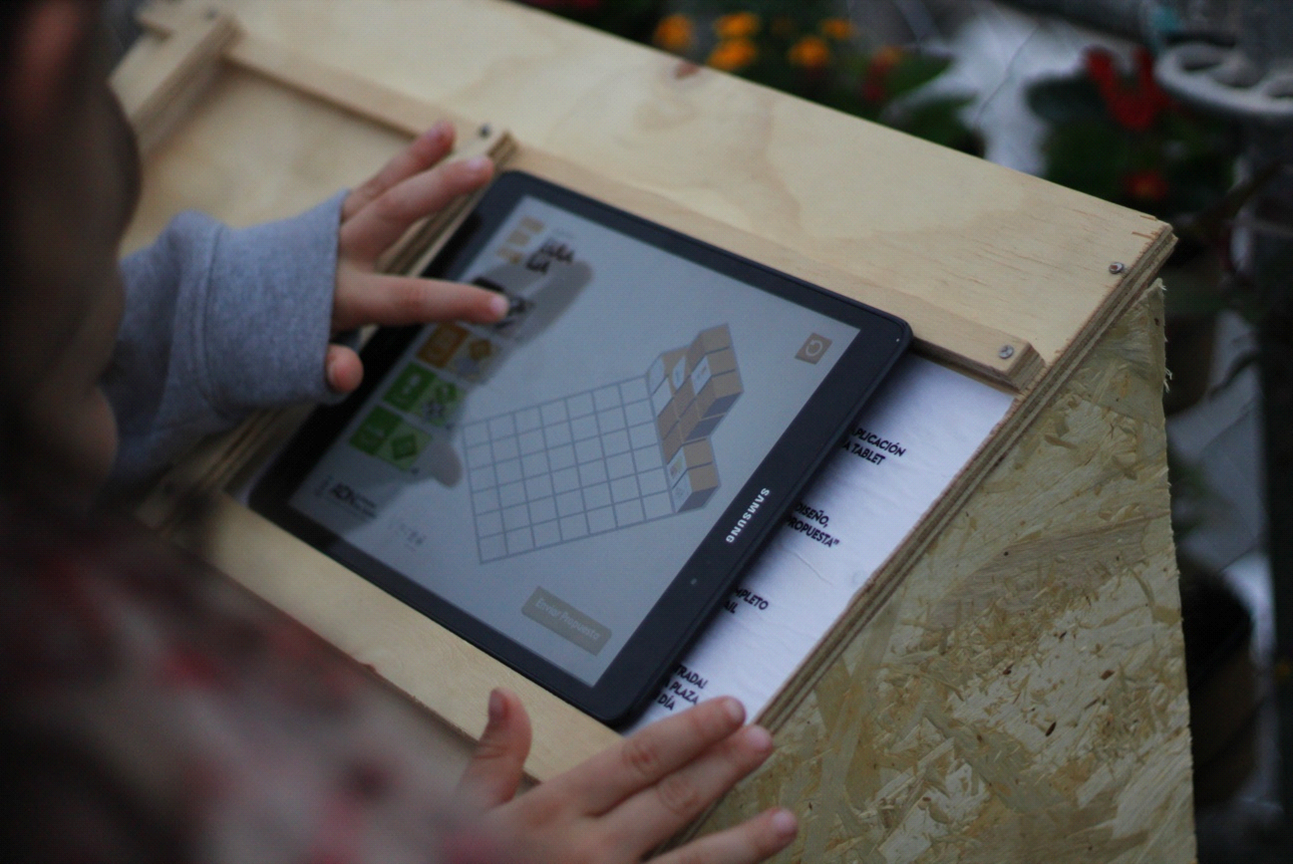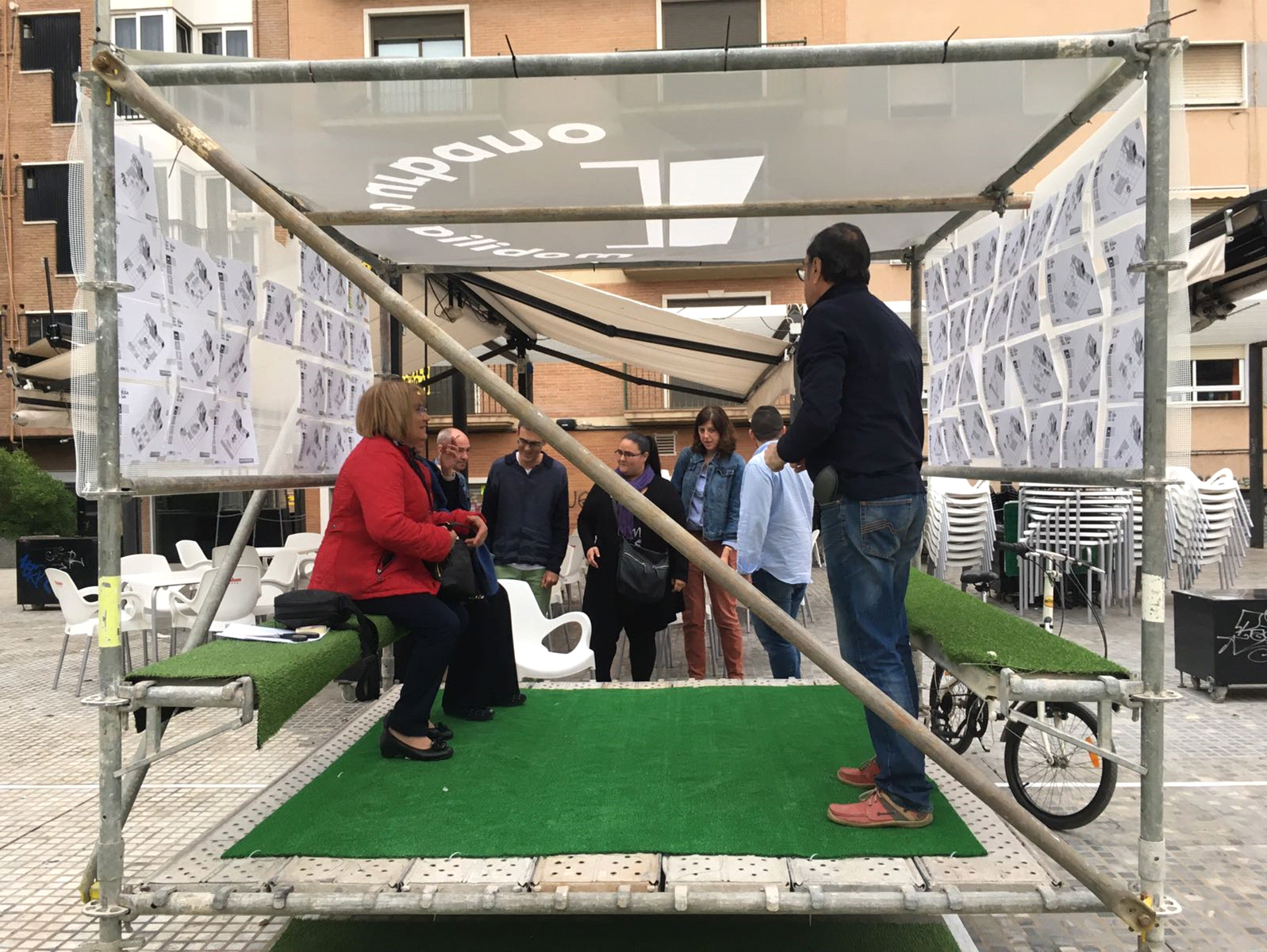CITYING URBAN PLAYERS: Your square “a la carte” - Plaza de Europa Case Study, City of Murcia.
Edited on
02 October 2018Abstract/Summary
Walking, talking, resting, seeing, perceiving... things citizens do as a part of their daily routines, aspects that take place in a context of continuous movement and transit, citizens are submerged in and part of a modern society and city where urban processes take place. Developing our cities at this point in time and with today’s technology at our disposal implies and calls for citizen participation, both active and passive, of all individuals part, also as a part of movements and citizen groups that themselves have been the main reason for the modifications and adaptations undergone by the neighbourhood due to the different generations and lifestyles, primary strategic aspects, either in a disorderly way or by means of an “informal spontaneity”.

Within this interesting, complicated and sometimes incomprehensible game board, the experimental project "Citying Urban Players" appears. Your square “a la carte”, encompassed in the framework of the urban revitalisation and activation project "MURCIA ADN URBANO" (Urban DNA Murcia), being Santa Eulalia the first neighbourhood to experience the process of citizen participation and full scale intervention. Taking Francesco Tonucci and his "City of children" (1) or the well-known "Playgrounds" put into practice by Aldo Van Eyck in Amsterdam (2), as a reference, the idea arose to devise a “game” that offered the possibility of involving the neighborhood in a direct and physical way, with the aim of dealing with issues of extreme importance at an urban level. Intentionally provoking the possibility of real change of a place chosen to that effect, a central square easily forgotten by citizens due to its conditions and spatial characteristics (there is nothing of significance there). All these actions, Walking, talking, resting, seeing, perceiving... can be encompassed and, above all, transformed into a fundamental concept that recognises the city and everything it attracts and develops, the verb "to inhabit".
Keywords: Inhabit, city, participation, space, urban, processes
Objectives
The project "Citying Urban Players" is born with a marked experimental and ephemeral character whose purpose is none other than to study the spatial propositions of citizens who spontaneously decided to get involved in this project. The Plaza de Europa square has been chosen as the physical space where the project will take place and, therefore, as the subject of our case study. The square is a public space built at the end of the 80s with a very little activity and a clear problem: its elevated position (above street and pavement/sidewalk level – 1,6 metres aprox.) as a deterrent to activation through different uses, poor distribution of vegetation not providing shade, a stunning lack of spaces for social recreation, etc. Another deterrent is the strong privatization of public space and neglect in the treatment of the urban landscape; streets and squares full of chairs, tables and advertisement in different formats. Al these aspects make strolling, talking, meeting and enjoying the urban surroundings a chimera >> as has been established by the urban x-rays conducted by the office of urban innovation Transversal Landscape in similar situations (3).
Collecting and analysing concepts as basic and fundamental as the sustainability in the use and the reuse of resources, we proposed the construction of an ephemeral urban installation that represents the experimental project and stands as "the landmark" from where to generate activity and citizen participation. For this purpose, the structure we proposed is a vertical garden that can be visited by neighbours and from which citizen participation could take place, be sparked and dynamised, by having citizens participate and interact with the square through a future re-structuring of the Plaza de Europa square.
As we can gather from “Recetes Urbanas”(4) -Urban Recepies- "Building is a collective exercise" according to its author Santiago Cirugeda, and if we talk about our cities, with even greater importance and sense. Where the need to join forces between administration, experts and citizens surges as a fundamental concept to reach urban experiences with a measurable success. This success lies within the social "feedback" that they provoke, and the project itself outsets from the constant search of recycling and a future use that allows produced and constructed elements to gain a second and and even third life as a part of other occurrences.
Furthermore, another main concern is always the environment and ecology, which in this case implied that the modules making up the vertical garden were made of small flower pots (coconut fiber with ecological certification), and filled with plants capable of being planted directly in the compost of any urban space adapted to that use.
 |
The concept of "Smart Cities" was one of the main challenges within this experience: how to accommodate participation, both offline and online. The solution to this duality is based on two main interventions, permitting the structure of the vertical garden to be visited and function as a viewpoint from where to view and envision the square from a bird's eye perspective, and the use of a an App that allows for direct participation from users and neighbours.
Methodology and Development
The union of these four concepts (sustainability, recycling, participation and smart cities) led to the development of "Citying Urban Players" by use of the following methodology:
Sustainability and recycling
From a first design stage the creation of a light structure, ephemeral and easy to assemble/disassemble was a priority, having to provoke a vision of momentariness and passenger elements, both physically and aesthetically, in the pedestrian. In this way, the scaffolding structures as used in the construction sector were the solution to this challenge and simply by looking at the structure, citizens would understood it has an expiration date.
Six square mobile structures and a certified scaffold structure for construction will be the structural supports. The image of street markets, such as can be found in the "Barrio de la Fama" known locally or (for a more global reference) the street markets of Taipei in China (5), and their adaptability and assembly/disassembly capacity in different situations in a matter of hours, supposed a unique opportunity whilst in the design period.
They are small squares or cities where there is a large infrastructure at street level, filling some spaces where, in many occasions, there is no such urban use and attraction. With this concept, the project adds the installation of modules of aromatic plants (with ecological certificate) that, somehow, reverts in the residents of the Santa Eulalia neighbourhood at the end of the project.
Therefore, we can understand the project as the composition of a neighbourhood market where a light, metallic and simple structure is dressed with elements that affect the citizens who demand its content and application, and once the process is finished the footprint left in the city is practically indiscernible.
 |
 |
Participation and `Smart Cities´
In order to carry out the project, two fundamental issues are established: the physical space and the digital space. When we speak of the physical space, in addition to the montage of the vertical garden accessible to the public even at its highest point, a grid is outlined on the square, clearly visible from a bird's-eye view. This grid will provide the bases of a simple system of spatial management of the six modules of scaffold with wheels and the six modules of artificial turf that compose the elements present in the square. These elements, which are interchangeable and relocatable every day, were the following:
- Two vegetation modules
- Two modules of urban furniture
- Two children's playground modules
- Six modules of artificial turf
As a way of differentiating and signalling the modules, at the top of each of these dynamic modules identification markers have been placed, with logos, etc. making it easier to visualize and distinguish them from the top of the vertical garden.
 |
 |
The digital space is developed through a mobile application that recreates the square with the grid and from where each citizen has the possibility to distribute this new urban space in the way they consider most convenient. When finishing the submission of your proposal it is sent on-line with your personal data to a database created for that purpose. Once all new designs have been submitted for the day, a citizen council formed by neighbours, institutions, experts and active agents decide which the winning configuration for the square is. After consensus, the neighbour, author of the design for the square, is notified, and informed that the next day the square will proudly carry the name of the winner.
 |
Conclusions
For a week "La plaza de Europa" (Plaza de Europa square) borrowed names from anonymous citizens like Maria, Ana, Juan or Ricardo who projected their concerns as neighbours. Their squares were full of activity, children playing in the playgrounds, curious visitors and photographers, people climbing to the top of the vertical garden accompanied by the smell of the aromatic plants. During this short period of time, the square was no longer a hard and dry place, without spaces for the children, lack of vegetation and without shade. More than 200 proposals for a new square distribution, 1000 plants that were given away to neighbours and bystanders during the afternoon the vertical garden was disassembled, taking up new spaces like balconies, roof-gardens, living rooms, etc. enriching Santa Eulalia. From the simplest concept of sustainability to the most complex concept of smart cities, a modern and inclusive, sustainable approach always needs the active participation of citizens. This starting point is a key part of future interventions at Plaza de Europa, where, far from large-scale interventions, small improvements must be made under responsible guidance by experts, attending the proposals already made "in situ", from which we can conclude and extract the guidelines for improving the square in a real, useful and desired way.
The future of cities and their public space is to establish a balance between "what has always worked" and what is now "starting to work", and from our point of view, this can be appreciated through this experience, and these would be the keys through which we can begin to understand the development of the social and urban process which is the city. And as Jane Jacobs (6) puts it, "Cities have the capacity to provide something for everyone, but only because, and only when, they are created for everyone", and it is from that perspective, we start to attain and perceive the great significance of inhabiting a city.
Authors
Carlos Pérez Armenteros / Dictinio de Castillo- Elejabeytia Gómez
VERBO estudio
Abril 2017
Bibliography
- Gehl, Jan. “La humanización del espacio urbano”. Ed.Reverté, S.A, Barcelona, 2006.
- Museo nacional Reina Sofía. “Playgrounds: reinventar la plaza”. Ed.Siruela, S.A, Madrid 2014.
- Jacobs, Jane. “Muerte y vida de las grandes ciudades”. Ed.Capitan Swing, Madrid 2011. (6)
- Gehl, Jan. “La humanización del espacio urbano”. Ed.Reverté, S.A, Barcelona, 2006.
- Tonucci, Francesco. “La ciudad de los niños”. Ed. Graó, Barcelona 2015. (1)
- Perec, Georges. “Especies de espacios”. Ed. Montesinos, Mataró 2014.
- Beekmans, Jeroen & de Boer, Joop. “The Pop-Up City”, Ed. BIS Publishers, Amsterdam, 2014 (5)
- Fuchs, Rudi. “Aldo Van Eyck: The Playgrounds and the City”, Ed. Liane Lefaivre, 2002 (2)
- Cirugeda, Santiago. “Situaciones Urbanas”, Ed. Tenov. 2014 (4)
- Maclean, Alex. “Up on the roof”, Ed. Princeton Archi, 2012
- Martínez, Andrés. “Habitar la cubierta”, Ed. Gustavo Gili, 2005
Articles
- Monteys, Xavier. “Rehabitar: domesticar la calle”, Ed. Ministerio de Vivienda, Madrid, 2010.
- Vidal, josé Manuel. “El juego: playscapes”, Revista Paisea, Valencia, 2012.
- Transversal, Paisaje. “Dimensiones de la privatización del espacio público”, Madrid, 2015 (3)
- Transversal, Paisaje. “A participar se aprende participando”, Madrid, 2012
Submitted by fvirgilio on
